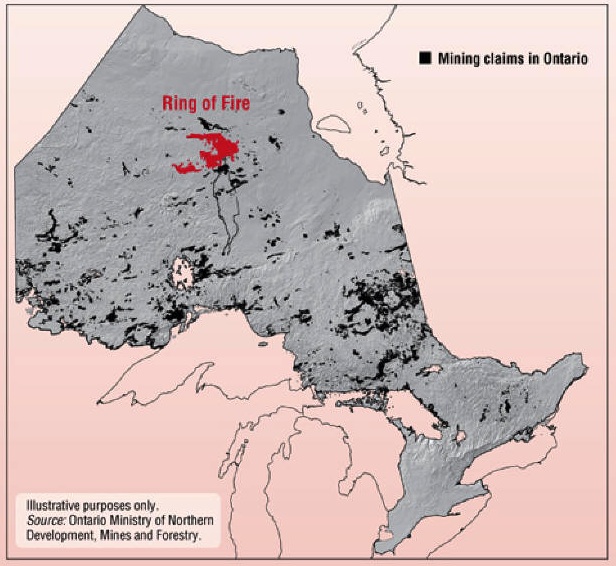If you follow mining in Canada you’ve certainly heard about the much hyped “Ring of Fire” or McFauld’s Lake area of northern Ontario. This area on the boundary of the Hudson Bay lowlands and boreal shield is Oji-cree and Cree territory. It is also where Cliffs Natural Resources and Noront Resources are proposing the first of what could be many mining projects in the remote and relatively pristine area.
MiningWatch recently had an opportunity to comment on an important document that will guide Cliffs in drafting the environmental assessment for their project, the latest draft of the Terms of Reference. As reported in the Wawatay News Cliffs initially gave First nations and “interested parties” like MiningWatch only 15 days to comment on hundreds of pages of documents. While the company justified this by saying it was a revision of a previously released document and the revisions were minor- a careful read of the documents showed this was not the case. In response to several requests Cliffs conceded to extend the deadline on comments until January 11.
Joining MiningWatch in submitting comments were the Wildlands League, Wildlife Conservation Society (WCS) and Vermillion River Stewardship.
Unlike the joint review processes we are involved with there is no public registry of submissions for this project so it’s hard to know who else may well have submitted comments. Certainly we expect some of the affected First Nations will have. Neskantaga First Nation has an outstanding request with the Ontario Government for mediation over the terms of reference.
MiningWatch, WCS and Wildlands League continued to voice demands for a broader and more participatory process – a demand that has also been made by First Nations and recommended by civil servants. MiningWatch’s comments pointed out that a joint review with the federal government would have resulted in a more efficient process of drafting the requirements by having one rather than two documents to review.
In their substance, the Terms of Reference were found to be lacking in a number of important ways. One of the principal concerns was over the exclusion of important alternatives from detailed, government and public scrutiny. An assessment of alternative ways of doing a project is a fundamental part of an environmental review process and is a requirement written into the environmental assessment act. Cliffs has said, however, that they’ve already ruled out most of the significant alternatives and are only proposing to review a small number of minor variations in the assessment.
The most significant alternative that Cliffs has excluded from further consideration is the transportation corridor to access the mineral deposits and move the bulky concentrate south. Competing views of how this could be achieved have been on the table for some time but all Cliffs has said about the alternatives is that their option is the only one that’s economically viable. They provide very little in the way of justification and no meaningful review of First Nations perspectives or environmental impacts in coming to this conclusion. The cursory treatment of this and other alternatives is clearly in violation of provincial guidelines and we and other commentators have put this in our submissions. We think the fact that Ontario has agreed to subsidize a part of the infrastructure to the area should motivate a higher standard for review - not a lower one.
Other comments included the need to take watershed scale approaches to potential impacts at the mine site and at the proposed processing site outside of Sudbury. The details on the cumulative effects assessment were too sketchy. All four of the NGOs requested greater detail and the inclusion of a larger number of projects in the cumulative effects assessment.
The next step for Cliffs is to submit their proposed Terms of Reference to the Ontario government who will decide to accept it as is or with revisions. There are no plans for further public consultation on this foundational document for the forthcoming assessment. While Cliffs has made claims of urgency and provincial and federal governments have focused on streamlining their respective assessments, the reality is with Cliffs facing major financial challenges throughout their operations this project is not moving forward immediately. We have the time and the responsibility to do a proper job, better examples exist in Canada. Sadly there seems to be little will on the part of the company, the province or the federal government to get it right.
